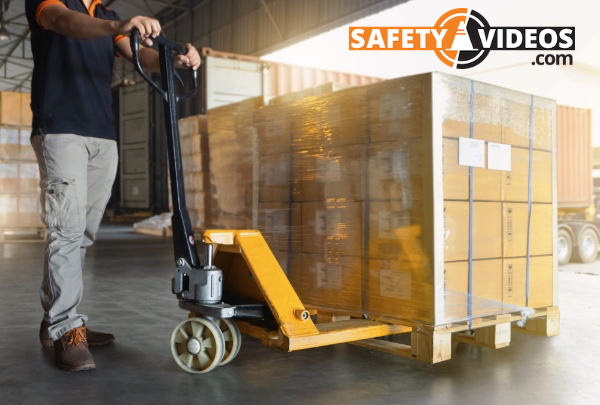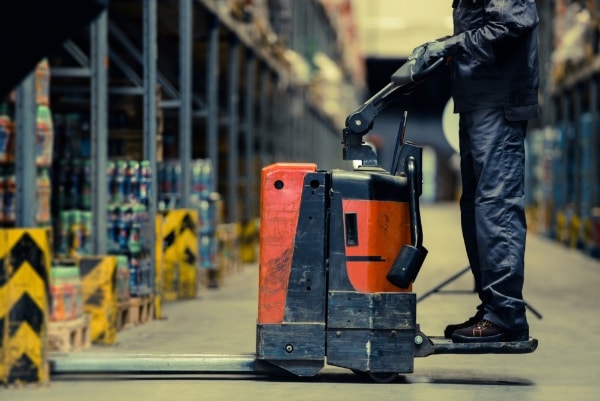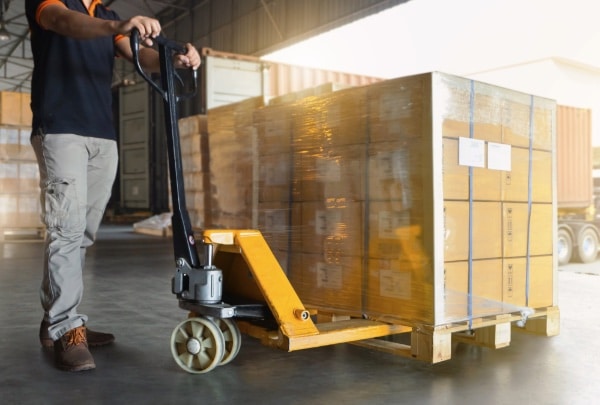Pallet Jack Toolbox Talk – [Quick & Easy for 2023]

Anywhere you can find heavy goods that need to be transported, you’re sure to find pallets. These wooden structures are a common sight in warehouses, manufacturing centers, and big box stores and are typically lifted and moved with the assistance of pallet jacks.
However, one of the keys to keeping employees safe and remaining OSHA compliant is by training your employees on how to use a pallet jack safely. That’s where this Pallet Jack Toolbox Talk comes in. We also offer a more comprehensive video-based pallet jack certification program.
Any time heavy loads are lifted and transported around a job site, serious injury is likely. Anyone who will operate pallet jacks in the workplace must be trained to use this equipment. Using good ergonomics when using a pallet jack can help reduce accidents and injuries.
Cover Pallet Jack Training With A Toolbox Talk
Holding an equipment safety meeting is a critical way to ensure all employees know the safe work practices expected of them as pallet jack operators. These pieces of training often take the form of toolbox talks like this one to quickly inform employees of the basics of workplace safety with this particular piece of equipment in mind.
Basic pallet jack safety meetings should cover such things as proper lifting techniques, correct safety equipment, how to load a pallet jack and the sorts of dangers to watch out for while operating these heavy-duty devices.
In addition to being federally required, safety training in the workplace has been shown to reduce costs associated with injury compensation, legal fees, and lost time at work. Investing in the health and well-being of your employees through equipment safety training is an important strategy for maintaining high morale, increasing productivity, and ensuring a safe and well-regulated work environment. Since the pallet jack falls into the Powered Industrial Truck Standard, training is required for all employees before using the pallet jack, and also on a specified and regular basis.

How Do You Use A Pallet Jack Safely?
Pallet jacks are an extremely helpful tool. When used properly, they make lifting and handling heavy loads much easier, reducing strain and lowering the risk of injury.
These are the best practices for the safe operation of this equipment in the workplace.
1. Wear Proper Safety Gear
Before operating this equipment, you need to put on protective gear. Wear gloves, steel-capped boots, and safety eyewear to protect vulnerable areas from injury.
Gloves and heavy-duty boots should also be worn any time you’re lifting or handling pallets with your hands, to avoid splinters or damage to toes from dropped pallets.
2. Load Slowly
Take your time while loading the equipment, especially if you’re transporting dangerous chemicals or handling a particularly heavy load. Rushing the loading process can result in dropped or broken materials, muscle strains and other injuries.
Before loading the machine, make sure you know any pinch points that could cause hand injuries.
Sometimes, it will be a multiple-person job lifting an extra large load. Be mindful of your own abilities and the carrying capacity of your equipment. If you’re ever uncertain whether you can manage a given load, ask for assistance.
3. Use Correct Operating Techniques
A loaded pallet jack should always be kept at a safe speed to avoid errors. Move slowly, maintaining awareness of your surroundings at all times, including the presence of any obstructions or pedestrians along your path.
Do not stand on the pallet jack while it is in motion or at any other time. Never ride on a pallet jack for fun, or for any purpose other than to use the equipment to lift pallets.
Remember always to push pallet jacks rather than pull them. Pulling a pallet jack places a huge strain on your shoulder muscles and can result in rotator cuff injury.
Never stand in front of a moving pallet jack. Additionally, never try to stop or brace the pallet jack with your foot. Keep your feet out from underneath the load at all times.

4. Be Careful with the Pallet Jack Handle
Never yank hard on the handle. Make sure you are aware of all relevant handle positions, including the raise position, neutral position, and lower position. Any time you are moving a load, the handle should remain in the neutral position.
Sometimes the jack may become stuck inside a pallet. If this happens, avoid throwing the handle or trying to force it out; instead, push gently but firmly down on the handle until the front wheels of the fork raise up a little. You should then be able to slide the jack out of the pallet safely.
5. Store Unused Pallet Jacks Safely
Pallet jacks not currently in use should always be stowed away from pedestrian traffic. Any equipment left on the floor or obstructing the main work area could constitute a major trip hazard.
Stow pallet jacks with the forks lowered under a shelf, beneath a table, or in another out-of-the-way location. Electric jacks should be plugged in while not in use so they will be fully charged the next time they are needed.
6. Conduct a Workplace Inspection Frequently
A clean and well-kept workplace is essential to safely operating pallet jacks. Floors should be kept dry and clear of obstructions at all times. Never push a pallet jack across a wet floor to avoid an increased risk of slipping and falling.
Make sure all operators of pallet jacks are aware of the locations of any ramps inside the workplace. Narrow aisles are also a potential risk, as the load could become stuck while maneuvering through.

Does OSHA Require Pallet Jack Training?
OSHA requires all employees to have training and certification before operating electric pallet jacks. Without completing an accredited training program, it is illegal for an employee to operate any powered industrial equipment.
Failure to comply with OSHA regulations can result in hefty fines and other serious consequences for your business. Besides, employees who aren’t properly trained risk injuring themselves and others while operating dangerous machinery. Therefore, it’s important to ensure all employees have the relevant certifications.
How Do You Inspect a Pallet Jack?
Regular inspections of all powered industrial trucks are vital to workplace safety. You should inspect your pallet jack before you load it every single time. Make sure to report any pallet jacks that aren’t working properly or seem to have broken or damaged components.
Here are some steps to take while inspecting a pallet jack.
Survey the machine’s exterior for any signs of damage, including excessive wear and tear on the loading area. Old and worn-out equipment should be replaced.
Examine the wheels, paying attention to any flat spots that prevent the machine from rolling easily. A pallet jack with faulty wheels will be challenging to operate, which could cause you to strain or tear your muscles in an effort to offset the difficulty.
Check for fluid leaks coming from the pallet jack, which could indicate a failing hydraulic unit. Any machines showing leakage signs should be immediately reported and removed from the work area.
Make sure electric pallet jacks are fully charged before use.
If any piece of equipment fails to pass inspection, alert a superior and ensure the faulty machine is stowed away so it won’t accidentally be used. Put a sign on the jack to alert other workers to the problem.

Manual Pallet Jacks vs. Electric Pallet Jacks
There are two major categories of pallet jacks: manual and electric. Both have different advantages and disadvantages that make them better or less suited to certain work environments.
A manual pallet jack is extremely durable and requires relatively little maintenance since no electric components exist. This makes them less complicated to operate and means they’ll stand up to rigorous use, which can be an advantage in a busy workplace. However, they take more effort to use and are harder to maneuver, and they can’t lift the heaviest loads.
An electric pallet jack makes lifting heavy loads easy and won’t strain your workers as much to operate, which can increase productivity. On the other hand, electric jacks require more training and employee certifications and cost more to purchase and maintain.
In Conclusion
The pallet jack is an essential piece of equipment for any job site where weighty loads are lifted. Safe operation of these machines is vital, whether you’re using a manual or an electric model. Using this Pallet Jack Toolbox Talk with your employees is a good step in keeping them trained and discussing the safety of using this machine at the top of their minds.
That said, an electric pallet jack requires more rigorous certification than a manual one to ensure all relevant safety procedures are followed. Regularly review these safety tips to ensure all employees remember their training and remember best practices while operating these machines.